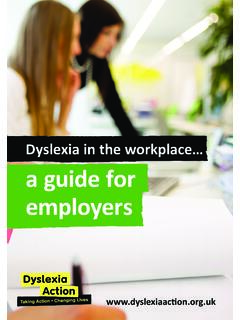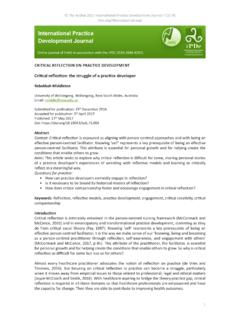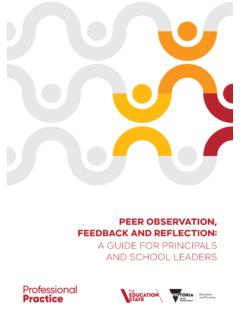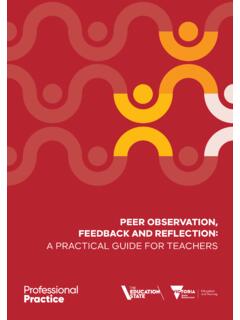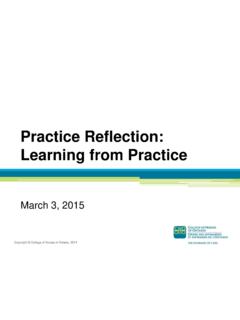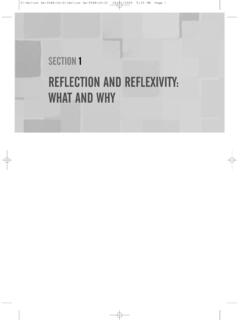Transcription of Critically reflective practice - University of Kent
1 197 Critically reflective practice is a process of inquiryinvolving practitioners in trying to discover, andresearch, the assumptions that frame how theywork. Critically reflective practitioners constantlyresearch these assumptions by seeing practicethrough four complementary lenses: the lens oftheir own autobiographies as learners of reflectivepractice, the lens of learners eyes, the lens of col-leagues perceptions, and the lens of theoretical,philosophical, and research literature. Reviewingpractice through these lenses makes us more awareof those submerged and unacknowledged powerdynamics that infuse all practice settings. It alsohelps us detect hegemonic assumptions assump-tions that we think are in our own best interests butthat actually work against us in the long aware of our assumptions is a puz-zling and contradictory task.
2 Very few of us canget very far doing this on our own. No matterhow much we may think we have an accuratesense of ourselves, we are stymied by the factthat we are using our own interpretive filters tobecome aware of our own interpretive filters. Thisis the equivalent of a dog trying to catch its tail,or of trying to see the back of your head while look-ing in the bathroom mirror. To some extent, we areall prisoners trapped within the perceptual frame-works that determine how we view our experi-ences. A self-confirming cycle often developswhereby our uncritically accepted assumptionsshape actions that then only serve to confirm thetruth of those assumptions.
3 We find it very diffi-cult to stand outside ourselves and see how someof our most deeply held values and beliefs lead usinto distorted and constrained ways of become Critically reflective , we need to findsome lenses that reflect back to us a stark and dif-ferently highlighted picture of who we are and whatwe do. When we embark on this journey, we havethe four lenses mentioned earlier. Viewing whatwe do through these different lenses alerts us todistorted or incomplete aspects of our assumptionsthat need further investigation. Let me say moreabout each of Journal of Continuing Education in the Health Professions, Volume 18, pp. 197 205. Printed in the Copyright 1998 The Alliancefor Continuing Medical Education, the Society for Academic Continuing Medical Education, and the Council on CME, Association forHospital Medical Education.
4 All rights FoundationsCritically reflective PracticeSTEPHEN BROOKFIELD, PhD, LLDD istinguished ProfessorSchool of EducationUniversity of St. ThomasSt. Paul, MNAbstract:The concept of critical reflection is frequently invoked as a distinguishing featureof good practice in continuing health education. But what exactly is critical reflection? Howis it recognized? What are its benefits? How can it be incorporated into professional prac-tice? This article explains the constituent elements of critical reflection and provides an exampleof how a Critically reflective approach can be taken toward continuous, formative lenses through which educators can view their practice Critically are outlined and the critical incident questionnaire is described.
5 The Critically reflective habit is proposed as a survival necessity for continuing health Works:Continuing health education, critical practice , critical reflectionReprint requests: Stephen Brookfield, PhD, LLD,Distinguished Professor, School of Education, Universityof St. Thomas, 2115 Summit Avenue, St. Paul, MN reflective Lens 1: OurAutobiography as a Learner of PracticeOur autobiography as a learner represents one ofthe most important sources of insight into practiceto which we have access. Yet, in much professionaleducation, personal experience is dismissed anddemeaned as merely anecdotal in other words,as hopelessly subjective and impressionistic. It istrue, of course, that at one level all experience isinherently idiosyncratic.
6 For example, no oneexperiences the death of a parent in exactly thesame way as anyone else, with the same mix ofmemories, regrets, affirmations, and pain. Yet, atthe same time, bereavement as a process of rec-ognizing and accepting loss contains a number ofpatterns and rhythms that could be described fact that people recognize aspects of theirown individual experiences in the stories others tellis one reason for the success of peer support groupsfor those in crisis or transition. As I hear you talkabout going through a divorce, struggling with ill-ness or addiction, or dealing with the death ofpartners, friends, and parents, I am likely to hearechoes of, and direct parallels to, my own expe-rience of these events.
7 The same dynamic holdstrue in teacher reflection groups. As we talk to eachother about critical events in our practice , we startto realize that individual crises are usually col-lectively experienced dilemmas. The details andcharacters may differ, but the tensions are essen-tially the our autobiographies as learnershas important implications for how we teach. Ourexperiences as learners are felt at a visceral, emo-tional level much deeper than that of reason. Theinsights and meanings for practice that we drawfrom these deep experiences are likely to have aprofound and long-lasting influence. They cer-tainly affect us more powerfully than methods orinjunctions that we learn from textbooks or hearfrom superiors.
8 We may think we are teachingaccording to a widely accepted curricular or ped-agogic model only to find, on reflection, that thefoundations of how we work have been laid in ourautobiographies as learners. In the face of crisesor ambiguities, we fall back instinctively on mem-ories from our times as learners to guide how werespond. As Denlico and Pope found, when teach-ers are asked to explain why they favor certainapproaches frequently they evidence their choiceof method, for instance, by reference to a forma-tive experience of their own, whether it be a pos-itive one which they seek to emulate for their stu-dents or a negative one which they strive to avoidreiterating for others (p.)
9 156).1 For example, teachers who were underesti-mated as students when they were in college arecareful not to make the mistake of underestimat-ing their own students. This predisposes them toallow students second chances, to renegotiatecourse requirements and deadlines, or to give stu-dents the benefit of the doubt when they are unableto do what they had promised. Teachers who werereluctant discussion participants in their own stu-dent days are not likely to dismiss noncontribu-tors to classroom discussions as mentally negli-gible, disengaged, or hostile. They may wellinterpret a student s silence as evidence of herbeing engaged in reflective analysis.
10 Remember-ing the cultural and psychological inhibitors to theirown discussion participation, they are moreinclined to create ground rules that acknowledgethe value of silence and that create space for our autobiographies as learnersoften helps explain to us those parts of our prac-tice to which we feel strongly committed, but thatseem unconnected to any particular pedagogicmodel or approach we have learned. Recallingemotionally charged dimensions of our autobi-ographies as learners helps us understand whywe gravitate toward certain ways of doing thingsand why we avoid certain others. Preferences thatseem instinctual ( , a liking for group work orindependent study, a tendency to personal disclo-sure or reticence, an emphasis on sticking toannounced plans, or a liking for breaking awayfrom structures) can often be traced back to situ-198 Critically reflective Practiceations in which we felt inspired or demeaned aslearners.







